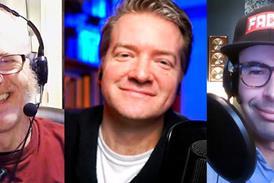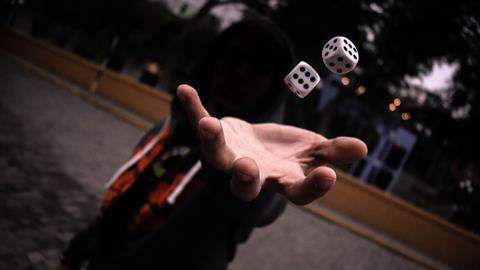Religious experience can count as more than just confirmation bias, says Christian philosopher Max Baker-Hytch.
The latest episode of The Big Conversation featured a discussion between the Australian atheist philosopher of religion Graham Oppy and the French Christian philosophical theologian Guillame Bignon. I listened to this episode with great interest, as the topic of what one might call “providential coincidences” seldom gets discussed by philosophers of religion despite the fact that these sorts of experiences are often a significant part of the way religious people arrive at their beliefs.
Bignon and Oppy made for a good pair of dialogue partners, not least because each was willing to grant that the other’s interpretation of the data before them was not manifestly crazy. Oppy, indeed, has expressed in writing the view that whilst he himself thinks that the total evidence makes better sense on the hypothesis of naturalism, it is possible nonetheless for a well-informed and reflective person to adopt a theistic view of reality without being irrational.
The centrepiece of the discussion was Bignon’s autobiographical account of his conversion from atheism to Christianity through a series of striking events that he is inclined to see as having been providentially arranged by God. Briefly, the events in question were an apparently chance encounter with an attractive American woman on holiday who invited the avowedly atheist Bignon to examine Christianity; then, following a prayer by Bignon asking God to reveal himself if He really existed, a medically unexplained injury to the shoulder Bignon most relied upon in playing volleyball on Sunday mornings, leaving him free to try out church attendance; and then, when Bignon had had enough of his experiment with a Sunday morning church service and made a dash for the exit, an overwhelming sensation of chills throughout his body that stopped him in his tracks and prompted him to enter into what would become a long-running dialogue with the pastor, who was able to help unravel Bignon’s central intellectual objections to Christianity.
‘Strikingly Juxtaposed Events’
Before we go any further, it will be helpful to adopt a religiously-neutral term for these sorts of experiences, one that neither affirms nor denies that God is behind such things. Let’s refer to them as Strikingly Juxtaposed Events, or SJEs for short. The question that occupied much of the ensuing discussion was whether SJEs have any evidential value for religious belief. As I mentioned, I take this to be a very important question given the way that SJEs feature so heavily in many people’s faith journeys.
I have had a few SJEs of my own, but one of the most striking examples I know of close at hand is that of an American friend of mine who felt that God was calling him to study for a doctorate in theology at Oxford. He and his wife were some way short of the money needed to put down his deposit for the first installment of tuition fees at Oxford, and after prayer and asking for help from friends and supporters at their church in California, they found that the sums of money that eventually came in from a variety of people all added up to exactly the amount they needed — to the cent — despite their not having told others the amount they needed.
How, then, should we go about assessing the evidential value of such occurrences? Bignon and Oppy didn’t explicitly talk about probability theory, but it was implicitly there in the background. Bayesian probability theory provides a helpful framework for thinking about the extent to which a fact or event raises or lowers the probability of a given hypothesis.
Coincidence or Design?
Just to take an example, suppose that we are comparing two hypotheses to try to account for a piece of evidence, namely, the leaves on a garden lawn forming the shape of a smiley face. Suppose that Hypothesis A says that the leaves were deliberately arranged that way by a human being and Hypothesis B says that the leaves were blown into that pattern by the wind. Bayes theorem tells us to consider whether the evidence (this arrangement of the leaves) is more probable (that is, is more to be expected) given Hypothesis A or given Hypothesis B. To the degree that it is more probable given A than given B, the evidence is said to confirm A over B. What’s known as the prior probability of the hypotheses is also crucial, though: suppose that Hypothesis A started out being vanishingly improbable because the leaves are on a lawn in a deserted high-walled garden that has been securely locked for months. In that case, the evidence (the leaf arrangement) may raise the probability of A but A could nonetheless end up less probable than B overall because of how far back A started off.
In the discussion about SJEs, Bignon’s hypothesis was that (some) SJEs are the result of God’s providence. Oppy’s hypothesis was that SJEs are sheer coincidences which will inevitably get thrown up from time to time on a planet of seven billion people and will tend to be interpreted as divine providence in cultures where belief in God is still prevalent.
Does one of these two hypotheses make SJEs more likely than the other? Bignon’s hypothesis makes experiences like Bignon’s and that of my friend quite likely. But if Oppy’s hypothesis makes these experiences roughly just as likely as Bignon’s does, then SJEs are not good evidence for God.
Get access to exclusive bonus content & updates: register & sign up to the Premier Unbelievable? newsletter!
Winning streaks and near misses
Oppy seems right to say that if you’ve got a large enough number of people in the world then every so often you’re bound to get clusters of striking events popping up that appear to be deliberately arranged despite not actually being so. For an analogy, if you roll a string of ten sixes on a die, you’ll be inclined to think that the die has been deliberately rigged. But if you have a large enough number of people in a room all rolling dice over and over again for days on end it becomes pretty likely that a string of ten sixes will crop up at some point, without the dice needing to have been rigged in any way.
It’s worth noticing, though, that whilst Oppy’s hypothesis does seem to predict that there would be striking clusters of events popping up every so often in a godless world, it also predicts that there would be at least as many near misses, so to speak; that is, Oppy’s hypothesis predicts there would be many clusters of events that nearly exemplify some striking pattern but fall slightly short of doing so. To go back to the dice analogy, if you have a large enough number of dice throwers throwing dice for long enough you’ll occasionally get a string of ten sixes; but you’ll get many more near misses, for example, near strings of sixes that are punctuated by a couple of fives. This is because there are many more ways of nearly getting a string of ten sixes than there are of getting a perfect string of ten sixes.
So, on Oppy’s hypothesis of sheer coincidence, for every cluster of events that manifests a striking, seemingly deliberate arrangement, there should be many more clusters of events that nearly manifest such an arrangement, and this is simply because there are many more ways for things to nearly exemplify a very striking pattern than there are ways for things to exemplify it perfectly. I suppose that what Oppy might say in reply is that this is indeed what happens in our world, but that the reason why we don’t notice most of the near misses is that our minds have an inbuilt tendency — a form of confirmation bias — to latch onto the “just right” instances and forget about the near misses.
This reply might work up to a point; surely it is true that we are less liable to remember near misses in some situations, especially in those cases where the near miss means that there isn’t much of interest for us to observe at all — just think how many car crashes you’ve probably nearly been in and yet had no idea you were nearly in. But I doubt whether this reply can work with some of the most striking examples of SJEs.
Returning to the example of my friend receiving various donations that added up to exactly the amount he needed despite the donors not having been told the target amount, it’s far more probable on Oppy’s hypothesis that my friend would have received roughly the right amount than that he would receive exactly the right amount, and it wasn’t as though my friend was regularly praying for very specific things like this. All that to say, it isn’t totally straightforward to assess the evidential value of SJEs, but I suspect that some SJEs — ones involving a very high degree of specificity and thus vastly many possible ways of having near misses — are more resistant to an Oppy-style explanation.
The prior probability of God
I mentioned earlier that the prior probabilities of the hypotheses are also crucially important. This relates to a part of the discussion in which Bignon explained that his experiences of SJEs weren’t the sole catalyst for his conversion, but rather, they were part of a broader tapestry that also involved his becoming persuaded that the New Testament is historically robust and that the person of Jesus is deeply attractive.
Another way of putting this might be that Bignon came to revise his view of the prior probability of the hypothesis of divine providence. He came to think that that hypothesis was not vanishingly improbable and so it wasn’t then a big stretch to interpret experiences of SJEs in his own life as being the result of God’s providential arrangement of events, even if a particular SJE taken in isolation wouldn’t be much more difficult to explain on Oppy’s naturalistic picture than on a theistic picture.
This reminded me of the move that Richard Swinburne makes in regard to the evidence for Jesus’ resurrection, to which I’m rather sympathetic. Swinburne points out that if we have some good reasons for thinking that there’s a God who might have an interest in communicating to humanity by entering into human history in a striking way, then the prior probability of a bodily resurrection of a person like Jesus is not vanishingly low, which in turn means that the direct historical evidence for Jesus’ resurrection (the discovery of the empty tomb and the post-mortem appearances to the disciples, etc) need not be overwhelmingly strong in order for it to be reasonable to think that God raised Jesus from the dead.
What about other religions?
The final part of the discussion centered on Oppy’s suggestion that SJEs seem to be involved not just in Christian faith journeys but also in non-Christian ones. He reasonably raised the question of whether it was simply special pleading for a Christian to regard SJEs that occur in Christian contexts as being the work of divine providence whilst discounting the non-Christian SJEs as being sheer coincidence. Bignon’s response seemed to be that he isn’t committed to any such blanket dismissal of non-Christian SJEs; some of them might, for all he knows, be the result of divine providence. Each case needs to be looked at on its own merits.
I take it that Oppy’s broader point was that the specifically Christian hypothesis of divine providence doesn’t seem to fit all that well with the occurrence of SJEs in the lives of non-Christian religious believers. Of course, the more impressive the non-Christian SJEs, the harder it would be to square them with specifically Christian theism. An important question, then, is whether there really is parity in terms of the frequency and impressiveness of SJEs across Christian and non-Christian contexts.
One notable phenomenon that Bignon didn’t mention but that seems very relevant here is that of converts from Islam to Christianity reporting having had dreams and visions of Jesus as part of their conversion experiences, often accompanied by apparent instructions in the dream or vision about where to find someone who can give them a Bible which turn out in reality to be accurate. Plenty of careful documentation of these reports exists, and they do seem to be quite widespread. As far as I have been able to ascertain, there is no similar phenomenon that parallels this in the opposite direction (e.g., Christians having dreams of Muhammad).
All in all, the Oppy-Bignon dialogue was a model of respectful dialogue around a topic that might have drawn ridicule and hostility from some interlocutors but which in this case led to a fruitful exploration of the epistemology of religious belief.
Click here to watch this episode of The Big Conversation.
Max Baker-Hytch received his PhD in Philosophy from Oxford University in 2014. He is Tutor in Philosophy at Wycliffe Hall, Oxford and is a member of the Philosophy Faculty at Oxford University. He also teaches at OCCA (The Oxford Centre for Christian Apologetics). Max has published scholarly articles on various topics at the intersection of analytic philosophy of religion and epistemology and is currently working on a book on divine hiddenness (see https://oxford.academia.edu/MaxBakerHytch).























